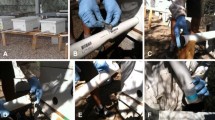Abstract
Varroa jacobsoni is an ectoparasite of honey bees which reproduces in capped brood cells. Multi-infestation is frequently observed in worker brood and can be interpreted as an aggregative phenomenon. The aim of this study was to determine whether the distribution of V. jacobsoni in worker brood cells relies on a random or an aggregative process. We studied the distribution of Varroa females in capped worker brood at similar age by comparing, by a Monte Carlo test, the observed frequency distribution of mites per cell to simulated distributions based on a random process. A complementary approach, using the "nearest neighbor distances" (NND) with Monte Carlo tests, was investigated to study the spatial distribution (a) between mites in different cells and (b) between infested cells in brood. The observed distributions did not differ significantly from that expected by a random process, and we conclude that there is no aggregation during invasion of V. jacobsoni in worker brood.
Similar content being viewed by others
Author information
Authors and Affiliations
Additional information
Received: 29 April 1999 / Accepted in revised form: 26 August 1999
Rights and permissions
About this article
Cite this article
Salvy, M., Capowiez, Y., Le Conte, Y. et al. Does the Spatial Distribution of the Parasitic Mite Varroa jacobsoni Oud. (Mesostigmata: Varroidae) in Worker Brood of Honey Bee Apis Mellifera L. (Hymenoptera: Apidae) Rely on an Aggregative Process?. Naturwissenschaften 86, 540–543 (1999). https://doi.org/10.1007/s001140050671
Issue Date:
DOI: https://doi.org/10.1007/s001140050671




